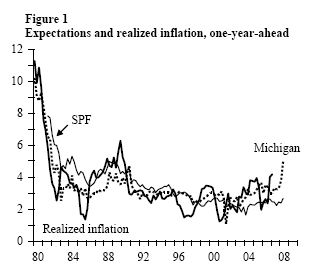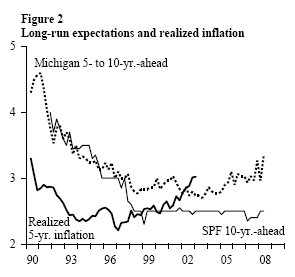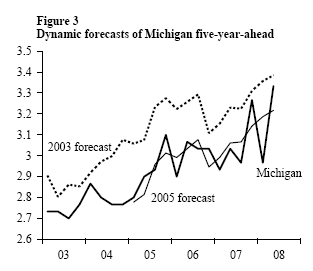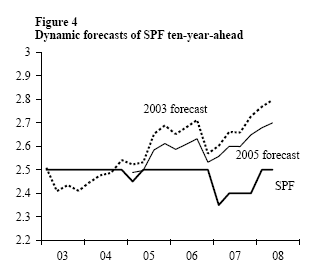Recent surveys have shown that households are expecting higher inflation in the future. These readings, coming at the same time as surging commodity prices, have raised concerns that inflation expectations are no longer well-anchored and that the Fed has lost credibility.
Recent surveys have shown that households are expecting higher inflation in the future. These readings, coming at the same time as surging commodity prices, have raised concerns that inflation expectations are no longer well-anchored and that the Fed has lost credibility. Unstable expectations could stoke higher inflation and possibly lead to a return to the stagflation of the 1970s.
In this Economic Letter, we argue that focusing only on whether the level of expected inflation has gone up may not be the best strategy for determining whether there has been a loss in credibility. Instead, it may be more useful to try to determine whether there has been a change in the way households and firms perceive the inflation process (and consequently form expectations about inflation). We use two surveys of inflation expectations, one based on household respondents, and the other on professional forecasters, to examine this issue. In neither case do we find evidence suggesting that expectations have recently become unanchored, even though consumer expectations of inflation have clearly gone up.
For households’ inflation expectations, we use the well-established monthly survey on consumer sentiment conducted by the University of Michigan’s Survey Research Center, which interviews a random sample of approximately 500 American households. Since 1977, the survey has asked how much respondents expect the consumer price index (CPI) to increase over the next year and over the next five to ten years.
The Survey of Professional Forecasters (SPF) is conducted quarterly by the Federal Reserve Bank of Philadelphia among approximately 50 private-sector economists who produce forecasts of macroeconomic variables on a regular basis. “Forecasters come largely from the business world and Wall Street…including chief economists at many Fortune 500 companies” (Croushore 1993). While the SPF does not release specific affiliations of its forecasting panel, they’ve consistently classified approximately half as affiliated with a “nonfinancial” firm (Chew and Price 2008). We look at the average CPI inflation predicted by the SPF panel over the next four quarters and over the next ten years.
 Figure 1 plots quarterly data for the four-quarter-ahead inflation expectations for each survey, as well as the realized inflation rate, where each quarter’s value shows the realized inflation rate over the subsequent four quarters. While inflation fell (at varying speeds) over most of this period, in the last few years it has moved above the lows recorded earlier in the decade. The Michigan survey (the median household’s expectation of CPI inflation over the next year) tracks realized inflation reasonably well; expected inflation was quite stable between 1992 and 2006, but began to increase in late 2007 and then spiked quite dramatically in the first part of 2008. The SPF forecast of CPI inflation tends to stay close to the household survey, though it has not risen as much in recent years.
Figure 1 plots quarterly data for the four-quarter-ahead inflation expectations for each survey, as well as the realized inflation rate, where each quarter’s value shows the realized inflation rate over the subsequent four quarters. While inflation fell (at varying speeds) over most of this period, in the last few years it has moved above the lows recorded earlier in the decade. The Michigan survey (the median household’s expectation of CPI inflation over the next year) tracks realized inflation reasonably well; expected inflation was quite stable between 1992 and 2006, but began to increase in late 2007 and then spiked quite dramatically in the first part of 2008. The SPF forecast of CPI inflation tends to stay close to the household survey, though it has not risen as much in recent years.
Figure 2 plots longer-term inflation expectations, along with realized inflation over a five-year period. The graph begins at 1990, since we do not have continuous data before then. Both measures of expectations as well as realized inflation fell in the first half of the 1990s, though they have diverged since then. It is notable that, since 1998, the ten-year SPF inflation forecast has rarely deviated from 2.5%. Its remarkable stability seems to exemplify perfectly Chairman Bernanke’s (2007) definition of well-anchored expectations:

So, for example, if the public experiences a spell of inflation higher than their long-run expectation, but their long-run expectation of inflation changes little as a result, then inflation expectations are well anchored. If, on the other hand, the public reacts to a short period of higher-than-expected inflation by marking up their long-run expectation considerably, then expectations are poorly anchored.
Household expectations, in contrast, are noticeably more volatile, falling to unusually low levels earlier this decade, then moving back up over the last couple of years or so. Although the Fed tends to focus on inflation as measured by the price index for personal consumption expenditures and not the CPI, a rough adjustment to these data (to make the two series comparable) suggests that even over a five- to ten-year horizon, households expect inflation to stay unpleasantly high (compared, for instance, to the levels that many members of the FOMC forecast three years out). It is these readings which have led to concerns about Fed credibility and about the possibility that we may be facing a sustained increase in inflation.
Looking for a loss of credibility
As discussed above, unpleasantly high expected inflation need not, by itself, constitute evidence that expectations have become unanchored or that the Fed has lost credibility. Instead, what one would like to show is that there has been a change in the way that economic agents (whether households or firms) perceive the inflation process. To explore this issue, we use a very simple model of inflation expectations in which we assume that this quarter’s survey reading on expected inflation depends upon only two things: last quarter’s survey reading and this quarter’s realized inflation rate.
The choice of this model is not meant to deny that other variables—such as food and energy prices—are relevant or to assert that households and professional forecasters have the same expectations process. Instead, we want to see what can be learned by using a common simple framework to explain different measures of expectations. Another reason for this strategy is the limited availability of data—especially for long-term inflation expectations—which makes it hard to distinguish between more complicated alternative models meant to explain the data.
The logic of the test is simple as well: If the Fed has only recently lost inflation-fighting credibility, then an equation estimated on historical data, covering the period before the Fed’s hypothesized loss of credibility, should tend to predict lower inflation expectations than we see in more recent expectations data. A simple model is enough for our purposes: If a simple model does not indicate a loss of credibility, then it is hard to argue that a more complex model would.
 We began by estimating the relationship between the five- to ten-year ahead expected CPI inflation rate from the Michigan survey and its value from the previous quarter together with the contemporaneous quarter’s CPI inflation rate using data over the 1990-2002 period. Our specification turned out to provide a reasonably good “explanation” of inflation expectations over this period.
We began by estimating the relationship between the five- to ten-year ahead expected CPI inflation rate from the Michigan survey and its value from the previous quarter together with the contemporaneous quarter’s CPI inflation rate using data over the 1990-2002 period. Our specification turned out to provide a reasonably good “explanation” of inflation expectations over this period.
We then took the estimated relationship and used it to predict the readings from the Michigan survey over the 2003:Q1-2008:Q2 period, using only the contemporaneous quarter values of realized inflation over this period. Figure 3 plots the resulting values along with the long-term expected inflation rate from the Michigan survey. The predicted values turn out to be slightly higher than the actual Michigan survey values, quite the contrary to what one would expect if expectations had become unanchored. Figure 3 also shows the results from a second exercise with the relationship estimated through the last quarter of 2004 and the forecast starting in the first quarter of 2005. The results track the actual Michigan expectations data quite well. We repeated this procedure for the four-quarter-ahead Michigan expectations and obtained similar results: The forecasts track the actual survey data extremely well, except for 2008:Q2.
 Figure 4 shows the results for long-term inflation forecasts from the SPF. Although our model slightly underpredicts the inflation forecast in the beginning, after 2004 the predictions lie above the actual values. The pattern of errors is noticeable as well, suggesting that, given recent inflation data, the SPF panel should have gradually raised its inflation forecast over this period. Instead, the panel seems almost to have ignored recent data showing higher inflation. We get very similar results when we try to explain recent readings on the SPF panel’s four-quarter-ahead inflation forecasts, though here it must be noted that the four-quarter-ahead inflation forecast does move around more than the ten-year-ahead forecast.
Figure 4 shows the results for long-term inflation forecasts from the SPF. Although our model slightly underpredicts the inflation forecast in the beginning, after 2004 the predictions lie above the actual values. The pattern of errors is noticeable as well, suggesting that, given recent inflation data, the SPF panel should have gradually raised its inflation forecast over this period. Instead, the panel seems almost to have ignored recent data showing higher inflation. We get very similar results when we try to explain recent readings on the SPF panel’s four-quarter-ahead inflation forecasts, though here it must be noted that the four-quarter-ahead inflation forecast does move around more than the ten-year-ahead forecast.
In the case of the professional forecasters, one could argue that the expectations process has changed, but the sign of our errors is the opposite of what we would expect if the Fed had lost credibility or if inflation expectations were adrift. Instead, these data suggest that the professional forecasters have little doubt that recent high inflation readings are temporary. It is worth noting that long-term inflation forecasts from another well-known survey—the Blue Chip—also have shown no tendency to increase over the last four or five years.
We also find no evidence that the Fed has lost credibility with households. Instead, the data indicate that households have always paid a great deal of attention to recent inflation data, even when forming expectations about inflation more than five years into the future. As long as households continue to form expectations in this manner, upward price pressures from commodity price shocks will raise even long-term expectations, but the positive implication is that these expectations will come back down once these shocks work their way through the system and inflation stabilizes.
While we cannot simply dismiss concerns that households’ elevated inflation expectations will set off the kind of wage-price spiral we saw in the stagflation of the 1970s, there are several reasons for optimism about inflation. First, unlike the 1970s, productivity growth remains high. Second, slackening labor markets will tend to put downward pressure on wages. Finally, to the extent that firms’ inflation expectations are closer to those of the SPF forecasters (whom they employ to forecast inflation, among other things) rather than to those of households, firms will be less willing to raise prices and so will not find it easy to meet any demands that workers might make for higher wages.
Wayne Huang
Research Associate
Bharat Trehan
Research Advisor
[URLs accessed July 2008.]
Bernanke, Ben S. 2007. “Inflation Expectations and Inflation Forecasting.” Speech delivered at the NBER Summer Institute, Cambridge, MA, July 10.
Chew, John, and Calvin Price. 2008. “Introducing: An Industry Classification for the Survey of Professional Forecasters.” FRB Philadelphia Research Department.
Croushore, Dean. 1993. “Introducing: The Survey of Professional Forecasters.” FRB Philadelphia Business Review (Nov./Dec.), pp. 3-13.
Opinions expressed in FRBSF Economic Letter do not necessarily reflect the views of the management of the Federal Reserve Bank of San Francisco or of the Board of Governors of the Federal Reserve System. This publication is edited by Anita Todd and Karen Barnes. Permission to reprint portions of articles or whole articles must be obtained in writing. Please send editorial comments and requests for reprint permission to research.library@sf.frb.org